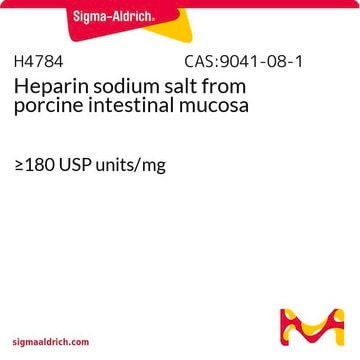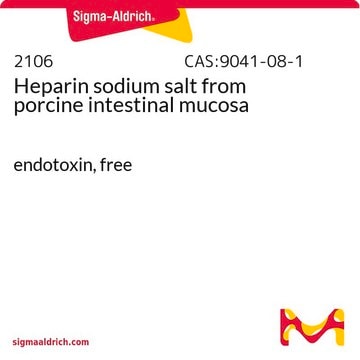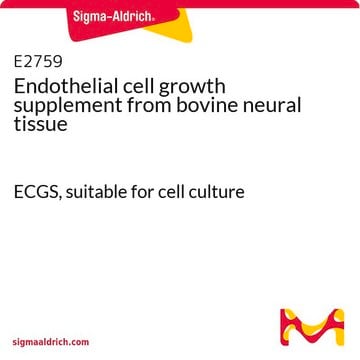The typical dosage of heparin for anticoagulation can vary based on the specific application and the type of blood product. For general anticoagulation, a common range is between 5 to 30 units of heparin per milliliter of blood. For cow's blood, the amount of this product needed will depend on the desired dosage and the volume of blood, which may be found in veterinary guidelines or literature. It is advisable to dissolve it in a saline solution or sterile water before use to ensure effective administration.
H3393
Heparin sodium salt from porcine intestinal mucosa
Grade I-A, ≥180 USP units/mg
Synonym(s):
Sodium heparin
Select a Size
$44.40
Select a Size
About This Item
$44.40
Recommended Products
biological source
Porcine intestinal mucosa
Quality Level
type
Grade I-A
form
powder
specific activity
≥180 USP units/mg
color
beige
useful pH range
5.0 - 7.5
solubility
H2O: 50 mg/mL, clear, colorless to faintly yellow
application(s)
clinical research
diagnostic assay manufacturing
life science and biopharma
storage temp.
room temp
Looking for similar products? Visit Product Comparison Guide
General description
Application
- to check the effect of heparin on FGF21 (fibroblast growth factor 21) signaling.[5][5]
- in immunostaining of mice brain sections[6]
- to quantify white blood cells and red blood cells in Sparus aurata blood samples[7]
- in anticoagulation and severe acute respiratory syndrome coronavirus 2 (SARS-CoV2) inhibition assay[8]
Biochem/physiol Actions
Heparin is synthesized in mast cells and mediators such as histamine and is associated with allergy and inflammatory activity.[10] Heparin shows therapeutic effects against venous thrombosis and pulmonary embolism, helps in preventing re-thrombosis post thrombolysis, and manages arterial thrombosis in patients who suffer from acute myocardial infarction. Heparin shows anti-inflammatory action in many inflammatory conditions such as burns, bronchial asthma, and ulcerative colitis.[2]
Other Notes
Recommended products
Comparable product
Related product
Storage Class
11 - Combustible Solids
wgk_germany
WGK 2
flash_point_f
Not applicable
flash_point_c
Not applicable
ppe
Eyeshields, Gloves, type N95 (US)
Choose from one of the most recent versions:
Certificates of Analysis (COA)
Don't see the Right Version?
If you require a particular version, you can look up a specific certificate by the Lot or Batch number.
Already Own This Product?
Find documentation for the products that you have recently purchased in the Document Library.
Customers Also Viewed
Articles
Uncover more about glycosaminoglycans and proteoglycans including the structure of glycosaminoglycans (GAGs), the different types of GAGs, and their functions.
Glycosaminoglycans are large linear polysaccharides constructed of repeating disaccharide units.
-
How do I calculate how much Heparin sodium salt I need to prevent coagulation in a gallon of cow's blood? Would it have to be dissolved in a saline solution first?
1 answer-
Helpful?
-
-
How can I determine the shelf life / expiration / retest date of this product?
1 answer-
If this product has an expiration or retest date, it will be shown on the Certificate of Analysis (COA, CofA). If there is no retest or expiration date listed on the product's COA, we do not have suitable stability data to determine a shelf life. For these products, the only date on the COA will be the release date; a retest, expiration, or use-by-date will not be displayed.
For all products, we recommend handling per defined conditions as printed in our product literature and website product descriptions. We recommend that products should be routinely inspected by customers to ensure they perform as expected.
For products without retest or expiration dates, our standard warranty of 1 year from the date of shipment is applicable.
For more information, please refer to the Product Dating Information document: https://www.sigmaaldrich.com/deepweb/assets/sigmaaldrich/marketing/global/documents/449/386/product-dating-information-mk.pdfHelpful?
-
-
How is shipping temperature determined? And how is it related to the product storage temperature?
1 answer-
Products may be shipped at a different temperature than the recommended long-term storage temperature. If the product quality is sensitive to short-term exposure to conditions other than the recommended long-term storage, it will be shipped on wet or dry-ice. If the product quality is NOT affected by short-term exposure to conditions other than the recommended long-term storage, it will be shipped at ambient temperature. As shipping routes are configured for minimum transit times, shipping at ambient temperature helps control shipping costs for our customers. For more information, please refer to the Storage and Transport Conditions document: https://www.sigmaaldrich.com/deepweb/assets/sigmaaldrich/marketing/global/documents/316/622/storage-transport-conditions-mk.pdf
Helpful?
-
-
please, could you explain me if this Heparin H3393 in one 'high molecolar wieght heparin'?
1 answer-
This product is a porcine heparin with a molecular weight range of 15-19 kDa. This material is considered a "high molecular weight heparin." According to the literature, low molecular weight heparins are those with a molecular weight of less than 8000 Da. See the link below to review a publication that may be helpful:
https://www.ncbi.nlm.nih.gov/pmc/articles/PMC10141002/Helpful?
-
-
How many grams of sodium heparin, derived from porcine intestinal mucosa, are contained in a single vial?
1 answer-
This product is sold by units and vial content will vary from lot to lot. The minimum activity specification is 180 units/mg. The lot-specific activity is reported on the Certificate of Analysis. The following values indicate the least amounts will be present in each pack size:
10 KU: 56 mg
25 KU: 139 mg
50 KU: 278 mg
100 KU: 556 mg
250 KU: 1389 mg
500 KU: 2778 mg
1 MU: 5556 mgPlease see the link below to review a sample or lot specific Certificate:
https://www.sigmaaldrich.com/product/sial/h3393#product-documentationHelpful?
-
-
What is the molecular weight of Heparin sodium salt?
1 answer-
The molecular weight is determined in-house for the product. The correct molecular weight range for this product is 15-19kDa.
Helpful?
-
-
How much Heparin sodium salt, is used to prevent coagulation?
1 answer-
It is suggested to use 15 to 30 units per mL of blood.
Helpful?
-
-
What is the Department of Transportation shipping information for this product?
1 answer-
Transportation information can be found in Section 14 of the product's (M)SDS.To access the shipping information for this material, use the link on the product detail page for the product.
Helpful?
-
-
What concentration of Heparin sodium salt, can I use to inhibit RNAse activity?
1 answer-
Heparin has been used at concentrations ranging from 100 to 500 μg/mL. This has been reported in the J. Biol. Chem., 248, 2095 (1973).
Helpful?
-
-
What is the best way to sterilize Heparin sodium salt?
1 answer-
Although solutions may be autoclaved at 121 °C for 5 to 10 minutes, we generally recommend sterile filtration. This is because prolonged autoclaving may have an effect on its activity.
Helpful?
-
Active Filters
Our team of scientists has experience in all areas of research including Life Science, Material Science, Chemical Synthesis, Chromatography, Analytical and many others.
Contact Technical Service









